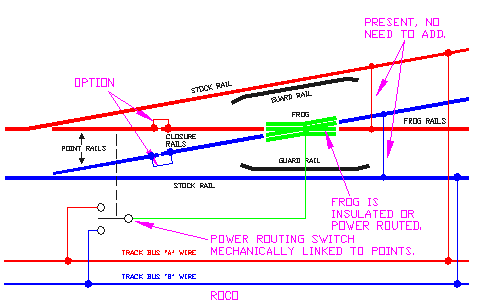Atlas & Roco Turnouts SUGGESTION #2-7: Atlas Turnouts Are Ready As Is - and - Soldering to Atlas Isolated Frogs. Code 55, 83, 100 (including Custom-Line Mark IV) Atlas turnouts are already DCC friendly. Their new turnouts still have those impossible-to-solder-to frogs. So what do you do? Screw a small brass screw into the one of the holes on their frog and solder to that. Easier yet, is a busbar and screws that Atlas sells through their parts department. You can buy the busbars (#9200002, $1.75 for 6) and the screws (9200001, $2.30 for 12). They are available from Atlas' online store. Not many hobby shops carry them any more. Call Steve Millenbach, Customer Service Manager, at Atlas Model Railroad. 1-908-687-0880 ext 7147. Option 1: The jumpers that I show for option one are present in some way. They are just touching the rail and may become unreliable over time. This might be cause poor electrical contact years down the road. Also, they may get hot under a short situation. Since I cannot see them and tell for sure, I suggest you add the option 1 bonds. Ed Oates says that he took a turnout apart and found the above to be true. He says that he can solder to the underside of the hinge rivet easily. He does not affect point movement. Just be sure not to get too much solder on the turnout. If it flows through the rivet onto the topside of the turnout, it may indeed affect movement. Connect the wire from the rivet to a bus as a feeder. Option 2: Drop feeders from the point rails to your bus. Ed also states that the closure and frog rails are a single piece of nickel-silver. One goes over the other inside the plastic covered frog; the metal frog top for customline and super switches are insulated from the rails underneath it by the same plastic. Since the corresponding frog and closure are a single piece of metal, they can be fed from the next track section via rail joiners or whatever technique one uses to feed any section of track. He says that he drop his feeders and connects to the power bus when he attached to the hinge as he mentions above. To avoid a short should someone come into the switch with the points thrown against them, I suggest you use a bulb. See section 2-17 for more on the bulb. See the track wiring section for more information on using light bulbs. Atlas has several lines of turnouts. All are basically the same. It is just that some look better than others for the modeler who wants a more realistic looking turnout. I used the Atlas HO Super-Track 83 line of their switches to write this section. How to Wire This Turnout: This section assumes you have read "How to Wire Turnouts" in the section on turnouts. 1. Connect the frog to your power routing switch or switch machine. 2. Connect your power routing switch or switch machine to your bus as shown in the above drawing. If the locomotive shorts when it goes across the frog, swap the wires that connect your power routing switch or switch machine to your bus. 3. Run a wire from each point rail to the corresponding bus wire as shown in color above. 4. Run a wire from each stock rail to the corresponding bus wire as shown in color above. Note: You do not need to use insulated joiners anywhere on this turnout. SUGGESTION #2-8: Roco Turnouts Are
Ready As Is.
Code 83, 100
 The Roco turnout is similar to the Atlas turnout. Both are already DCC friendly. Roco has made things a bit easier than Atlas. They provide a connector on the side of the turnout to power route the frog. Nice! The feeds from the track bus wire do not need to be attached where I have shown them. You may use the connector pins provided. Mine are shown where they are simply for clarity of the drawing. Personally, I use the connector for the frog only. I solder the wires to the stock rails for consistency with all my other track work. The jumpers shown above as "Present, no need to add" are visible and adequate for the job should a short occur. Option: Drop feeders from the points or solder bonds across the point to closure rail hinge. This will give you reliable electrical contact to the points for years to come. The Atlas/Roco Track 83 turnout has been discontinued in the United States. That may be a good thing, the point rails break off the throwbar very easily. How to Wire This Turnout: This section assumes you have read "How to Wire Turnouts" in the section on turnouts. 1. Connect the frog to your power routing switch or switch machine. 2. Connect your power routing switch or switch machine to your bus as shown in the above drawing. If the locomotive shorts when it goes across the frog, swap the wires that connect your power routing switch or switch machine to your bus. 3. Run a wire from each point rail to the corresponding bus wire as shown in color above. 4. Run a wire from each stock rail to the corresponding bus wire as shown in color above. Note: You do not need to use insulated joiners anywhere on this turnout.
|
Copyright by Allan Gartner 1996 - 2013 © All rights reserved. You may print this for your own, personal, non-commercial use. Non-commercial, non-personal reproduction may be requested by visiting wwww.WiringForDCC.com/writeme.htm . All users, commercial and non-commercial, may link only to this site at www.WiringForDCC.com. Thanks to all who contribute to this site and the Q&A forum! |